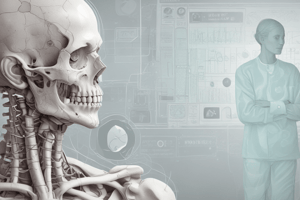Podcast
Questions and Answers
Where is the dorsalis pedis pulse typically located?
Where is the dorsalis pedis pulse typically located?
- Posterior surface of the calf
- Medial surface of the ankle
- Superior surface of the foot between the bases of the 1st and 2nd metatarsals (correct)
- Lateral surface of the ankle
What is the normal respiratory rate in an adult?
What is the normal respiratory rate in an adult?
- 10-14 breaths per minute
- 18-22 breaths per minute
- 20-25 breaths per minute
- 14-18 breaths per minute (correct)
What is the term for a respiratory rate below 12 breaths per minute?
What is the term for a respiratory rate below 12 breaths per minute?
- Bradypnea (correct)
- Dyspnea
- Hypoxia
- Tachypnea
What is the unit of measurement for blood pressure?
What is the unit of measurement for blood pressure?
What is the term for the maximal pressure that occurs during ventricular contraction?
What is the term for the maximal pressure that occurs during ventricular contraction?
What is the typical format for recording blood pressure?
What is the typical format for recording blood pressure?
What is the importance of standing on the patient's right-hand side during an examination?
What is the importance of standing on the patient's right-hand side during an examination?
What is the first step in the general examination framework?
What is the first step in the general examination framework?
What does the 'C' in ABCD stand for during a general examination?
What does the 'C' in ABCD stand for during a general examination?
What is the purpose of assessing a patient's built during an examination?
What is the purpose of assessing a patient's built during an examination?
What is the AVPU score used for?
What is the AVPU score used for?
What is included in the vital data collection during a general examination?
What is included in the vital data collection during a general examination?
What is the purpose of regional examination during a general examination?
What is the purpose of regional examination during a general examination?
What is the significance of inspecting a patient's facial features during a general examination?
What is the significance of inspecting a patient's facial features during a general examination?
What is the normal oral temperature in Celsius?
What is the normal oral temperature in Celsius?
What is the term for a pulse rate less than 60 beats per minute?
What is the term for a pulse rate less than 60 beats per minute?
Which of the following is a cause of hypothermia?
Which of the following is a cause of hypothermia?
What is the site of measurement for axillary temperature?
What is the site of measurement for axillary temperature?
What is the term for a pulse rate more than 100 beats per minute?
What is the term for a pulse rate more than 100 beats per minute?
What is the best place to assess the pulse volume?
What is the best place to assess the pulse volume?
What is the position of the patient in lateral decubitus?
What is the position of the patient in lateral decubitus?
What is included in the ABCD (appearance-built-colors-decubitus) examination?
What is included in the ABCD (appearance-built-colors-decubitus) examination?
Flashcards are hidden until you start studying
Study Notes
Patient Assessment
- Lateral decubitus: patient lies on one side
- Prayer position: leaning forward, commonly seen in pericardial effusion
General Examination
- Mentality
- Mental status exam
- Orientation: name, place, and date
- Concentration
- Mental status exam
- ABCD (Appearance-Built-Colors-Decubitus)
- Appearance
- Physical appearance: body type, race, personal hygiene
- Behavior: alert, lethargic, calm, agitated
- Characteristic facial features
- Built: body type and weight
- Colors: skin color and features
- Decubitus: patient's position
- Appearance
- Vital data
- Temperature (Temp)
- Heart Rate (H R)
- Blood Pressure (BP)
- Respiratory Rate (RR)
- Oxygen Saturation (O2sat)
- Random Blood Sugar (RBS)
- Regional examination
- Head
- Neck
- Upper limb
- Lower limb
- Lymph nodes
Vital Signs
- Temperature (Temp)
- Normal oral temperature: 37°C
- Rectal temperature: 0.5°C higher than oral
- Axillary temperature: 0.5°C lower than oral
- Fever: temperature > 37.2°C
- Hypothermia: temperature < 35°C
- Pulse examination
- Pulse rate: expressed in beats per minute
- Pulse rate < 60 bpm: bradycardia
- Pulse rate > 100 bpm: tachycardia
- Pulse examination sites:
- Radial artery
- Brachial artery
- Carotid artery
- Femoral artery
- Popliteal artery
- Posterior tibial artery
- Dorsalis pedis artery
- Blood Pressure (BP)
- Measured in mmHg
- Recorded as systolic pressure/diastolic pressure
- Respiratory Rate (RR)
- Normal RR in adults: 14-18 breaths per minute
- RR in children:
- 0-6 months: 30-40 breaths per minute
- 3 years: 20-30 breaths per minute
- 6 years: 18-25 breaths per minute
- 10 years: 17-23 breaths per minute
- RR < 12: bradypnea
- RR > 20: tachypnea
Examination Framework
- Each system examination is divided into general and local examination
- Local examination for each system:
- Inspection (looking)
- Palpation (feeling)
- Percussion (tapping)
- Auscultation (listening)
Studying That Suits You
Use AI to generate personalized quizzes and flashcards to suit your learning preferences.



